Canceled denominations of United States currency
The United States has several coins and banknotes which were proposed at one time but never adopted.
Banknotes
A three dollar bill was proposed two times during the 1860s. A design was engraved for a potential $3 United States Note, and a 1865 law called for a $3 National Bank Note, but neither proposal came to fruition.
| Denomination | Obverse | Reverse | Notes |
|---|---|---|---|
| $3 note | 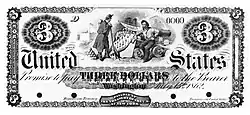 |
 |
Not to be confused with fake or privately issued obsolete notes or the three-dollar Continental currency banknotes issued during the American Revolution |
Coinage
There have been several United States coins which were proposed but never adopted. Most of the coins listed below, although never adopted, were produced in limited numbers as patterns.
| Denomination | Obverse | Reverse | Weight | Diameter | Material | Edge | Minted | Notes |
|---|---|---|---|---|---|---|---|---|
| Silver center cent 1¢ |
 |
 |
4.48 g | 24.00 mm | Cu (ring) Ag (plug) |
reeded | 1792 | The first and only US bi-metallic coin until the 2000 Library of Congress ten dollar coin. |
| Ring cent 1¢ |
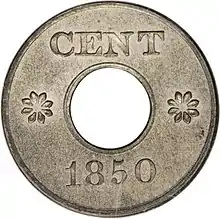 |
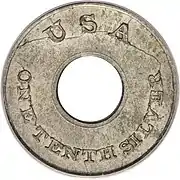 |
various weights | 90% Cu
10% Agα |
various | 1850–1851, 1853β, 1884–1885 | 196 ring cents (originals and restrikes) are known to exist.[1] Examples exist with or without a hole. | |
| Aluminum cent 1¢ |
 |
 |
0.937 g | 19.05 mm | 96% Al 4% trace metals |
plain | 1973–1975 | |
| Two-cent billon 2¢ |
_(obv).jpg.webp) |
_(rev).jpg.webp) |
3.84 g | ~13.00 mm | 90% Cu 10% Ag |
plain | 1836 | |
| Two and a half cent piece 2.5¢ |
unknown | unknown | unknown | unknown | never minted | Proposed in 1916 by US mint director Robert W. Woolley.[2] Civil War tokens of this denomination exist. | ||
| Three-cent bronze 3¢ |
 |
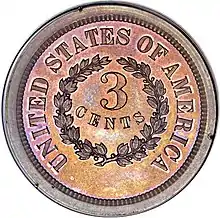 |
10.89 g | 28.57 mm | 95% Cu 5% Zn |
plain | 1863 | |
| Ring nickel 5¢ |
.jpg.webp) |
.jpg.webp) |
plain | 1884–1885 | [3][4] | |||
| Gold ring half dollar 50¢ |
.jpg.webp) |
.jpg.webp) |
1852 | [5] | ||||
| Gold ring dollar $1 |
.jpg.webp) |
.jpg.webp) |
1849, 1852 | [6][7] | ||||
| Two dollar piece $2 |
unknown | unknown | unknown | unknown | never minted | Proposed but not minted.[8] Some privately struck renditions exist.[9] | ||
| Stella $4 |
 |
 |
7.00 g | 22 mm | 6.00g Au 0.30g Ag 0.70g Cu |
reeded | 1879–1880 | |
| Half-union $50 |
_Obverse.jpg.webp) |
_Reverse.jpg.webp) |
83.58 g | 50.80 mm | 90% Au 10% Cuγ |
reeded | 1877 | Commemorative coins of this denomination were issued in 1915.
Several bullion coins are produced in this denomination. |
| Union $100 |
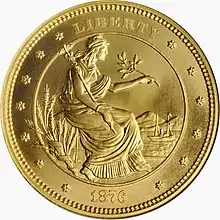 |
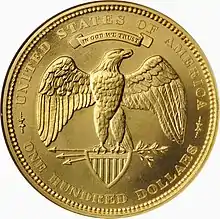 |
unknown | unknown | 90% Au 10% Cu |
unknown | never minted | Canceled before any patterns could be minted (fantasy coin shown).
Some commemorative and bullion coins are minted in this denomination. |
Notes
- ^α Pattern coins for the ring cent were struck in various metals, including copper, aluminum, and nickel, as well as billon.
- ^β 1853 ring cents are restrikes dated 1850, although they can be distinguished from the original 1850 cents in that they use a different reverse design.
- ^γ Although circulation strikes of the Half Union were to be 90% gold 10% copper, only two of the twenty known pattern coins were struck with this composition. The other 18 were struck in 100% copper, although some were later plated with gold by the mint.[10]
References
- "1792-1856". uspatterns.stores.yahoo.net. Retrieved 2019-03-24.
- "Mint proposed 2.5-cent piece in 1916". Coin World. Retrieved 2019-03-22.
- "J1724/P1934". uspatterns.com. Retrieved 2019-06-25.
- "J1742/P1954". uspatterns.com. Retrieved 2019-06-25.
- "J135/P162". uspatterns.com. Retrieved 2019-06-25.
- "J115/P130". uspatterns.com. Retrieved 2019-06-25.
- "J136/P163". uspatterns.com. Retrieved 2019-06-25.
- "Dr. Sol Taylor: Our Odd-Denomination Coins". Retrieved 22 March 2019.
- "Coin Designs by Daniel Carr. 1987-2001 Apollo Astronaut dollar, two dollar bi-metallic circulating coins". Retrieved 23 March 2019.
- "Fifty Dollar". uspatterns.stores.yahoo.net. Retrieved 2019-03-27.
This article is issued from Wikipedia. The text is licensed under Creative Commons - Attribution - Sharealike. Additional terms may apply for the media files.